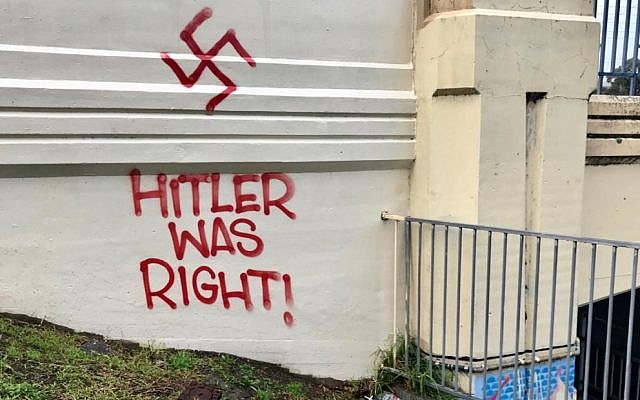‘It’s time for Australia to ban the swastika’
'Allowing the public showcasing of the swastika or other Third Reich paraphernalia violates our rights to feel safe'.
“I myself, meanwhile, after innumerable attempts, had laid down a final form; a flag with a red background, a white disk, and a black swastika in the middle. After long trials I also found a definite proportion between the size of the flag and the size of the white disk, as well as the shape and thickness of the swastika.”
So wrote Adolf Hitler in Mein Kampf of his efforts to design a flag for his new political party, noting that in the swastika he found, “the mission of the struggle for the victory of the Aryan man”.
Over the last few years, we have seen the forces of hate unleashed and infiltrate our community with frightening intensity, as the darkest and most horrific emblem in our culture looms large over our daily lives.
Homegrown white supremacists and far-right radicals have surged out of the shadows, and the swastika is their preferred tool to sow fear, harass, intimidate and terrorise.
Swastika graffiti has skyrocketed, on private properties and banners, and is appearing with alarming regularity wherever the public roams. Even the promenade at the iconic Bondi Beach was daubed with this hateful symbol earlier this year.
The situation is so worrying, that over the weekend, PM Morrison felt the need to condemn the continuing spike in swastika vandalism, which he described as “absolutely sickening and disgraceful”.
And those inflamed with virulent bigotry, who are using the swastika as a rallying cry to celebrate the murderous legacy of the Third Reich, have the law on their side.
That’s right, the public display of the swastika in Australia is not illegal.
At present, your next-door neighbour could fly the Nazi flag, or as we saw in Brighton earlier this month, it could appear within the Star of David on a private property.
It is indisputable that for an overwhelming majority of Australians, seeing the swastika, forever to be associated with crimes against humanity and genocide, daubed on their fence, or on a walking trail, or near a train station, is as threatening as being confronted with a gun.
Whatever country you come from and whatever language you speak, seeing the visible representation of the Nazi party induces feelings of revulsion and horror.
And if you are the child or the grandchild of a Holocaust survivor, it tears a hole in your heart, and puts you on edge knowing that those using it could harbour similar malevolent intentions as the Nazis who almost wiped out an entire people.
The monstrosities with which the swastika is linked must never be forgotten.
As Steven Heller, author of The Swastika: Symbol Beyond Redemption? explains, “The swastika is unredeemable because not only is it linked so indelibly to the Nazi crimes, but because it is still worshipped by the neo-Nazi haters … it is a weaponised symbol of racism and antisemitism.”
Indeed, for a country known for its multicultural fabric, this contagion of hate is pushing our tolerance to a breaking point.
It means that a long-deferred reckoning on how to deal with this stain must now take place.
Considering the painful effect the swastika has on its intended victims, it is an unacceptable reality that in 2019 our elected officials have yet to ban public displays of the swastika or other Nazi insignia.
There are people on our streets openly parading around these symbols of evil.
At a recent Shabbat dinner I heard from a woman who was confronted by an individual wearing a swastika armband at Oakleigh library. She felt in fear for her own safety, as did the mother with two children who saw that man outside the Carnegie library last year.
Above all, we owe it to the victims, the survivors, and to the diggers who fought Hitler and sacrificed their lives in order to ensure his ultimate defeat, to once and for all close the lid on this issue.
It is worth reminding everyone what the Nazi swastika represents – the shooting of one million unarmed Jewish civilians in 1941 including more than 33,000 Jews in just two days at Babi Yar; the gassing of nearly three million Jews in the death camps; the murder of more than 70,000 German citizens who had been diagnosed with mental and physical disabilities; the killing of the Roma, Sinti, homosexuals and political opponents; the enslavement of millions across Europe, and the bloodiest war in history, causing more than 50 million deaths.
Can anyone look the survivors in the eye and convince them that this is simply about freedom of speech when we know that these racists, who seek to destroy the touchstones of our democracy like dignity and equality, are the enemy of our shared ideals?
The only place where a swastika should be shown is in the classroom and the museum.
This is not a two-sided argument.
Allowing the public showcasing of the swastika or other Third Reich paraphernalia violates our rights to feel safe. It is a threat and an incitement to violence.
A number of countries have outlawed Nazi symbols – Germany, Italy, Austria, Czech Republic, Slovakia, and a raft of eastern European countries.
There should be no place for this symbol in Australia, proud as it is of its ethnic, religious and racial diversity.
I plan on launching a “denazification” campaign to urge local councils as well as the state and federal governments to ban the public showcasing of Nazi symbols. I hope others will join this effort.
And yes, nothing in life is simple, and there are rarely straightforward answers to complicated problems.
But every once in a while there is an opportunity to right a wrong, and to define the boundaries of our moral landscape.
It’s time to do the right thing, Australia.
Dvir Abramovich is chairman of the Anti-Defamation Commission.


comments